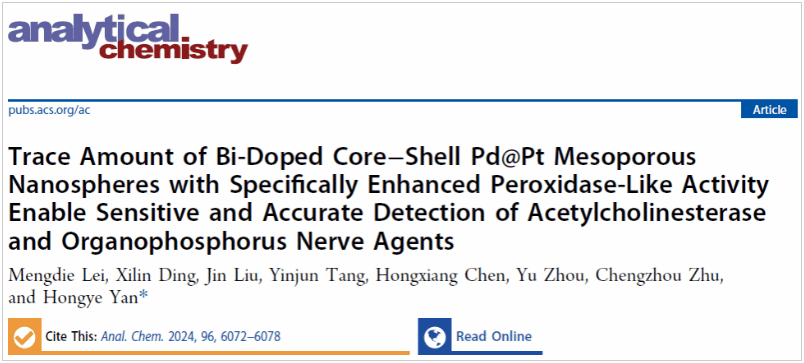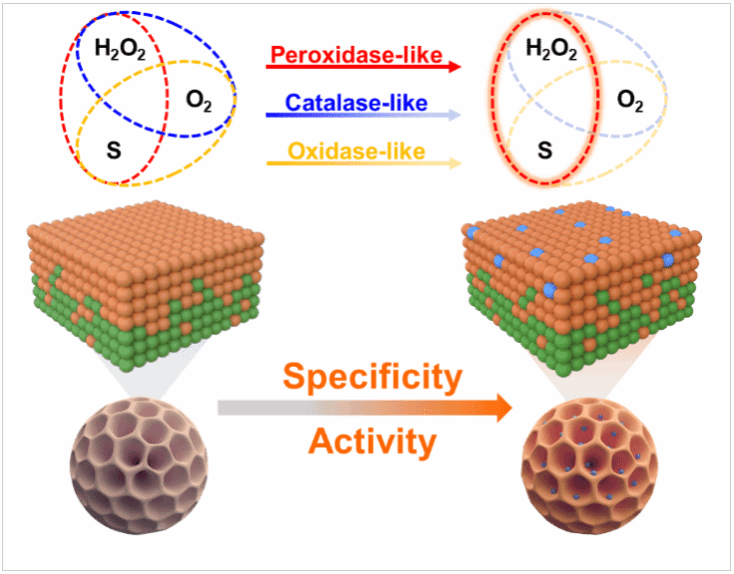Published by: School of Chemistry and Chemical Engineering, Edited by: Chen Machuan
WUST News Recently, young teacher Yan Hongye from the School of Chemistry and Chemical Engineering of the WUST, in collaboration with the team of Professor Zhu Chengzhou from Central China Normal University, published a research paper entitled “Trace Amount of Bi-Doped Core–Shell Pd@Pt Mesoporous Nanospheres with Specifically Enhanced Peroxidase-Like Activity Enable Sensitive and Accurate Detection of Acetylcholinesterase and Organophosphorus Nerve Agents” in the journal Analytical Chemistry. Student Lei Mengdie is the first author, Yan Hongye is the corresponding author, and the School of Chemistry and Chemical Engineering and the Hubei Key Laboratory for Coal Conversion and New Carbon Materials are the first units of the paper.

The development of rapid, accurate and sensitive detection methods for acetylcholinesterase (AChE) and organophosphorus pesticides (OP) is crucial for the protection of human health and the preservation of the ecological environment. The colorimetric method based on noble metal-based nanozymes has the advantages of simple operation and rapid response, and has been widely used for the determination of OP and AChE activities. Since noble metal-based nanozymes usually exhibit multiple enzyme activities, such as peroxidase (POD), oxidase (OXD), and catalase (CAT) activities, they can easily cause interference from dissolved oxygen and unnecessary loss of substrate hydrogen peroxide in colorimetric detection, which may affect the sensitivity and accuracy of detection. Therefore, the development of noble metal-based nanozymes with high activity and selectivity is important for this type of colorimetric sensor.
In this study, the specific POD-like activity of core-shell mesoporous Pd@Pt nanozymes was enhanced by doping with trace amounts of hetero-metal Bi. Among them, the atomic-level component regulation can not only effectively prevent the aggregation of doped metal atoms, but also the strong interaction between the ultra-low concentration of doped metal and the noble metal support at the atomic level can significantly modify the electronic structure of the active site, thereby specifically improving its catalytic activity. Studies have shown that the POD-like activity of trace Bi-doped Pd@Pt mesoporous nanospheres (Pd@PtBi2) is more than 4 times higher than that of Pd@Pt. In addition, the OXD-like and CAT-like activities of Pd@PtBi2 are not significantly enhanced, which effectively prevents the interference of dissolved O2 in the measured liquid sample and the unwanted consumption of substrate H2O2, which is conducive to ensuring the sensitivity and accuracy of detection. Based on this, a sensing platform based on Pd@PtBi2 was developed to achieve sensitive detection of AChE activity. Furthermore, by using the cascade catalysis of Pd@PtBi2 and AChE, a colorimetric biosensor for OP was established. This sensor has high sensitivity and anti-interference ability, with a detection limit of 0.06 ng mL-1. This study provides an effective strategy for designing of noble metal-based nanozymes with high specificity and high POD-like activity, and will effectively promote the application of this type of nanozymes in colorimetric biosensing. (School of Chemistry and Chemical Engineering of WUST)
